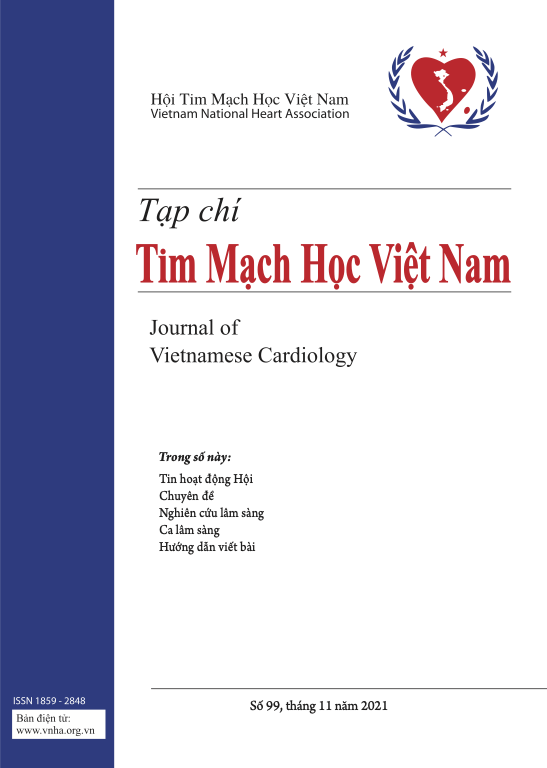Nhận xét tình hình tăng áp động mạch phổi nặng tại Viện Tim mạch Việt Nam, Bệnh viện Bạch Mai
Tóm tắt
Đặt vấn đề & mục tiêu nghiên cứu: Tăng áp động mạch phổi là tình trạng tổn thương mô bệnh học và huyết động phổi thường gặp ở bệnh lý tim bẩm sinh có tăng lưu lượng phổi và TAĐMP tiên phát. Bệnh thường được chẩn đoán muộn với biểu hiện của suy tim phải. Ở giai đoạn nặng, bệnh có tỷ lệ tử vong rất cao, nguy cơ phải ghép phổi lớn. Nghiên cứu thực hiện nhằm xác định tỷ lệ TAĐMP nặng ở nhóm TAĐMP do bệnh TBS và tiên phát, nhận xét các biểu hiện trên lâm sàng và cận lâm sàng cũng như khả năng điều trị sửa chữa toàn bộ của nhóm bệnh nhân này và xác định tỷ lệ biến cố ở nhóm TAĐMP nặng có thai.
Đối tượng và phương pháp nghiên cứu: Nghiên cứu mô tả thực hiện trên 105 bệnh nhân TAĐMP tại Viện Tim mạch Việt Nam, Bệnh viện Bạch Mai từ tháng 5/2014 - tháng 8/2015.
Tài liệu tham khảo
1. Ngọ Văn Thanh và cộng sự (2013). Đánh giá áp lực động mạch phổi giai đoạn chu phẫu trên bệnh nhân tim bẩm sinh tăng áp lực động mạch phổi nặng.
![]()
2. Nguyễn Thị Nhung, Trương Thanh Hương (2015). Nhận xét đặc điểm tim bẩm sinh người lớn tại phòng Tim bẩm sinh và di truyền tại Viện Tim mạch Bạch Mai.
![]()
3. Nguyễn Ngọc Thanh, Trương Thanh Hương (2015). Nhận xét tình trạng thai sản ở phụ nữ mắc tim bẩm sinh tại Viện Tim mạch Việt Nam, Bệnh viện Bạch Mai.
![]()
4. 2015 ESC/ERS Guidelines for the diagnosis and treatment of pulmonary hypertension, European Heart Journal Advance Access published August 29, 2015.
![]()
5. Humbert M et al. Am J Respir Crit Care Med 2006.
![]()
6. Badesch DB et al. Chest 2010.
![]()
7. Gaine SP, Rubin LJ. Lancet 1998.
![]()
8. Galie N, Manes A, Palazzini M et al. Management of pulmonary arterial hypertension associated with congenital systemic-to-pulmonary shunts and Eisenmenger’syndrom. Drug 2008;68:1049-1066.
![]()
9. Lowe BS, Therien J, Ionescu –Ittu R, et al. Diagnosis of pulmonary hypertension in congenital heart disease adult population impact on outcomes. J Am Coll Cardiol 2011;58:538-546).
![]()
10. Vongpatanasin W,et al. Ann Intern Med 1998;128: 745 - 55.
![]()
11. Kidd L, et al. Circulation 1993; 87:38-51.
![]()
12. Vogel M, et al. Heart 1999; 82: 30-3.
![]()
13. Simonneau G et al. J Am Coll Cardiol 2009.
![]()
15.Kanmogne GD. Curr Opin Pulm Med 2005.
![]()
16. Peacock AJ et al. Eur Respir J 2007.
![]()
17. Gaine SP, Rubin LJ. Lancet 1998.
![]()
18. Vanja Petrovic, MD, Christopher J Ryerson, MD FRCPC, and Robert D Levy, MD FRCPC Long-term survival in idiopathic pulmonary arterial hypertension associated with massive pulmonary artery dilation Can Respir J. 2011 May-Jun; 18(3): e50-e51.
![]()
19. Avila, W.S., et al., Pregnancy in patients with heart disease: experience with 1,000 cases. Clin Cardiol, 2003. 26(3): p. 135-42.
![]()
20. Bao, Z., et al., [Analysis of high risk factors for patient death and its clinical characteristics on pregnancy associated with pulmonary arterial hypertension]. Zhonghua Fu Chan Ke Za Zhi, 2014. 49(7): p. 495-500).
![]()
21. Humbert M et al. Am J Respir Crit Care Med 2006; 2. Hachulla E et al. Arthritis Rheum 2005.
![]()
22. Simonneau G, Robbins I, Beghetti M, Channick RN, Delcroix M, Denton CP, Elliott CG, Gaine S, Gladwin MT, Jing ZC, Krowka MJ, Langleben D, Nakanishi N, Souza R. Updated clinical classification of pulmonary hypertension. J Am Coll Cardiol 2009;54(Suppl):S43-S54.
![]()
23. Ni XH1, Tao XC, Zhang JQ, He JG, Liu ZH, Xiong CM, Luo Q, Zhang HL, Liu YQ Zhonghua Xin Xue Guan Bing Za Zhi. The prognosis study of 108 idiopathic pulmonary arterial hypertension patients 2009 Aug;37(8):708-11.
![]()
24. Sohrabi B1, Kazemi B1, Mehryar A1, Teimouri-Dereshki A1, Toufan M1, Aslanabadi N1. Correlation between Pulmonary Artery Pressure Measured by Echocardiography and Right Heart Catheterization in Patients with Rheumatic Mitral Valve Stenosis (A Prospective Study). Onlinelibrary.wiley.com/doi/10.1111/ echo.13000/pd.
![]()
25. Sandeep Sahy and Adriano R.Tonelli Pericardial effusion in pulmonary arterial hypertensionPulm Circ. 2013 Sep; 3(3): 467-477.
![]()
26. Duffels MG, Engelfriet PM, Berger RM, van Loon RL, Hoendermis E, Vriend JW, van der Velde ET, Bresser P, Mulder BJ Pulmonary arterial hypertension in congenital heart disease: an epidemiologic perspective from a Dutch registry. Int J Cardiol. 2007 Aug 21; 120(2):198.
![]()
27. Bedard, E., K. Dimopoulos, and M.A. Gatzoulis, Has there been any progress made on pregnancy outcomes among women with pulmonary arterial hypertension? Eur Heart J, 2009. 30(3): p. 256-65.
![]()
28. ESC Guidelines on the management of cardiovascular diseases during pregnancy. European Heart Journal, 2011. 32: p. 3147-3197.
![]()
29. The Criteria Committee of the New York Heart Association. (1994). Nomenclature and Criteria for Diagnosis of Diseases of the Heart and Great Vessels. (9th ed.). Boston: Little, Brown & Co. pp. 253–256.
![]()
30. Siu SC, S.M., Colman JM, Alvarez AN, Mercier LA, Morton BC, Kells CM, et al., Prospective multicenter study of pregnancy outcomes in women with heart díease. Circ J, 2001. 104: p. 515-521.
![]()
31. McLaughlin VV, Archer SL, Badesch DB, Barst RJ, Farber HW, Lindner JR, et al. American College of Cardiology Foundation Task Force on EXpert Consensus Documents; American Heart Association; American College of Chest Physicians; American Thoracic Society, Inc; Pulmonary Hypertension Association. ACCF/ AHA 2009 expert consensus document on pulmonary hypertension: a report of the American College of Cardiology Foundation Task Force on EXpert Consensus Documents and the American Heart Association developed in collaboration with the American College of Chest Physicians; American Thoracic Society, Inc; and the Pulmonary Hypertension Association. J Am Coll Cardiol 2009;53:1573-619.
![]()
32. Michael D. McGoon, Garvan C. Kane. “Pulmonary Hypertension: Diagnosis and Management” Mayo Clin Proc. February 2009; 84(2): 191-207
![]()








